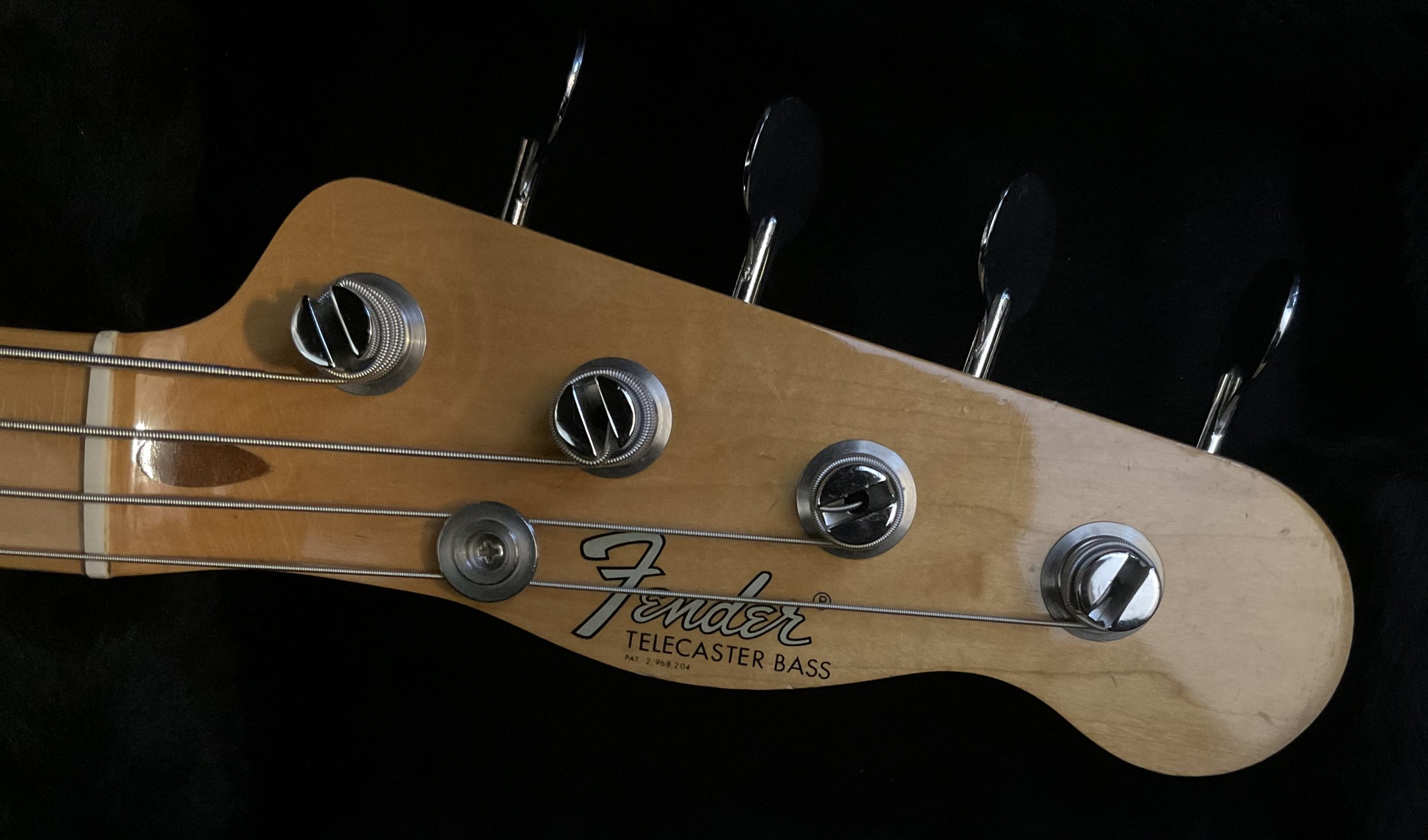1968 Fender Telecaster Bass
My 1968 Fender Telecaster Bass
The Telecaster Bass was introduced by Fender in 1968. It’s basically a reincarnation of the original 1951 Precision Bass with a white, instead of a black, pickguard. In fact, the Fender website even refers to the Tele Bass as the company’s first reissue. I think my fascination with this instrument started as a little kid when I first saw a photo of one in the 1969 Fender catalog. I loved the photos in the 1968 and 1969 Fender catalogs. The squared-off edges of the slab body, combined with the one single-coil pickup, gives the Tele Bass the look of a no-frills instrument that was meant to hold down that bottom groove. My fascination only increased by occasionally seeing a Tele Bass being played by the backing bands of various guest artists on country music TV shows like “Hee Haw” during the late 60s and early 70s. I just liked the way the Telecaster Bass looked - it seemed to have a certain “presence”.
My Telecaster Bass has a neck date of 23May68, so it is definitely from the first year of production. The single-coil version was produced until 1971, but then Fender transitioned to a new Tele Bass design that employed a single humbucker pickup in the neck position. Humbuckers seemed like they were becoming all the rage at that time. Fender also changed the shape and increased the size of the pickguard on this 2nd version Tele Bass, thereby eliminating the chrome control plate. I have both versions of the Tele Bass, and the humbucker version is a very different animal from its single-coil predecessor. My preference is the single-coil version - it has a full, deep sound with some bite and a touch of growl. The humbucker version is a great instrument too --- just a more mellow, rounder sound. It all depends on what you’re going after.
I purchased my Telecaster Bass from a music store in Rapid City, South Dakota in 2000. It was all original, at least when I bought it. However, a few months after I received the instrument, I opened the case one day and saw that the pickguard had fractured into 5 or 6 pieces. I was in shock – it was just fine the last time I played it, although in retrospect there were telltale signs that something was going on, like the strings in the area over the body getting slightly corroded. I thought maybe it was just the sweat and oils from my skin, although I had never seen strings get corroded like that before. I removed the pickguard pieces and placed them in a zip lock baggie – I guess I was desperately hoping I could somehow glue them back together. I had no idea what had happened. Was there some caustic chemical in the guitar polish that I had used? Was there some mysterious substance in the case lining that reacted with the pickguard plastic? Was the bass exposed to some stressing environment during the shipping process, like extreme hot or cold temperatures, and this was the delayed reaction from that exposure? Within a couple of weeks the 5 or 6 large pieces in the baggie had fractured into dozens of pieces. Most of them eventually disintegrated into dust. So much for my naïve hope of salvaging the pickguard.
I did some online research and quickly found the answer to the mystery. It appears the material used by Fender for some of their early single ply pickguards was prone to chemical breakdown and outgassing as they aged. Tortoise shell and pearloid pickguards are made of a different material and do not have this problem, or at least were not as susceptible. If you find a 1968-1971 1st version Telecaster Bass that has a truly original white pickguard, take the pickguard off and you’ll likely find it is actually a pearloid pickguard that has been flipped over. Fender did that type of thing on a routine basis to use up whatever stock they had on hand.
I still don’t know why my Tele Bass waited 32 years before the pickguard disintegrated. Maybe the chemical process simply takes that long to initiate, and it was just a coincidence it happened shortly after I purchased the bass. Maybe the change in climate from South Dakota to Southern California triggered or accelerated the process. Maybe the previous owner didn’t keep the bass in a case very much, allowing the corrosive gases to dissipate. I don’t know the answer.
The replacement pickguard with custom drilled holes looks great
So, having solved the basic mystery, I thought it would be easy to order an aftermarket, 11-hole, single ply white replacement pickguard and I’d be on my way. Not so fast. I quickly found the hole locations on the aftermarket pickguards did not match the existing holes in my Tele Bass body. Most of the holes would match just fine, but at least several would be off by 1/16” to 1/8”, too far off to get the screws in. I’m embarrassed to admit I bought several aftermarket pickguards in search of one that would work, but none of them lined up completely. I didn’t want to drill any new holes in the body of my precious 1968 instrument, so I eventually had a replacement pickguard made without any preexisting holes, and I transferred the hole locations to the new pickguard and drilled and countersunk them myself.
I’d have to say my 1968 Telecaster Bass is my “go to” bass, and I use it on a regular basis. I always take the chrome pickup and bridge covers off when I play it (they get in the way), but I certainly like the way it looks with the covers installed. An example of what my Tele Bass sounds like in action can be found at Dark Clouds On The Horizon | The Future of the World (bandcamp.com).
Related Links


